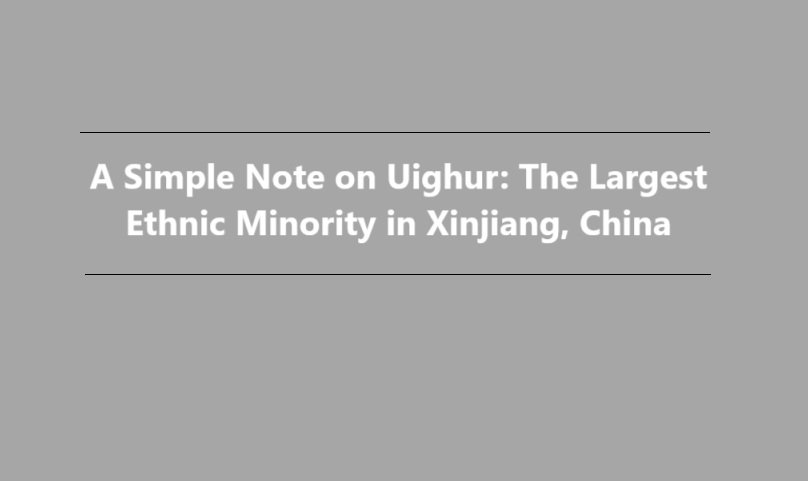
Introduction
The Uighurs, also spelled Uyghurs, are a Turkic ethnic group primarily residing in the Xinjiang Uighur Autonomous Region (XUAR) of northwestern China. They are one of the 55 officially recognized ethnic minorities in China, but their history, culture, and identity have often placed them at odds with the Chinese government. Over the past decade, Xinjiang has drawn significant international attention due to allegations of human rights abuses against Uighurs and other Muslim minorities. Reports suggest that the Chinese government has been detaining millions of Uighurs in what it calls “vocational training centers” but what many international organizations and human rights groups refer to as detention camps or re-education camps.
The Uighur Identity and Cultural Heritage
Uighurs have a distinct language, culture, and religious background that differentiate them from the Han Chinese majority. Their language, Uighur, is a Turkic language written in a modified Arabic script. Historically, the region of Xinjiang, meaning “New Frontier,” has been a crossroads of various civilizations, including Persian, Mongol, and Islamic influences. Islam is a key component of Uighur identity, with the majority of the population adhering to Sunni Islam.
Xinjiang was an important part of the ancient Silk Road, which facilitated trade between China, Central Asia, and Europe. The region saw periods of independence and foreign rule, with the Uighurs establishing their own states at different points in history. However, in 1949, after the Chinese Communist Party (CCP) took control of China, Xinjiang was incorporated into the People’s Republic of China.
Allegations of Human Rights Violations
Over the past decade, reports from the United Nations (UN), human rights organizations, and investigative journalists have accused the Chinese government of systematic repression against Uighurs and other Muslim minorities in Xinjiang. Some of the major allegations include:
- Mass Internment Camps: It is estimated that between one to three million Uighurs have been detained in so-called “vocational training centers.” These camps are alleged to function as forced re-education facilities aimed at eradicating Uighur culture, religious practices, and language in favor of assimilating them into Han Chinese society.
- Surveillance and Suppression: The Chinese government has implemented a high-tech surveillance state in Xinjiang, using artificial intelligence, facial recognition, and DNA tracking to monitor Uighur citizens. Many reports suggest that Uighurs are arbitrarily detained based on religious practices, foreign connections, or even having a beard or wearing a headscarf.
- Forced Labor: Investigations have revealed that many Uighurs are forcibly transferred from Xinjiang to work in factories across China. Reports claim that global supply chains, including those of major fashion, technology, and automotive brands, may be linked to forced Uighur labor.
- Religious and Cultural Suppression: Mosques, shrines, and religious sites have reportedly been destroyed or repurposed. The government has banned religious practices, including fasting during Ramadan, wearing religious attire, and teaching Islamic traditions to children.
- Forced Sterilization and Population Control: Some reports indicate that Uighur women have been subjected to forced sterilization, abortions, and contraceptive measures as part of efforts to reduce Uighur birth rates. This has been described by some experts as a form of demographic genocide.
China’s Official Position
The Chinese government denies all allegations of human rights abuses and instead claims that the measures in Xinjiang are necessary for counterterrorism and national security. Beijing argues that the region has faced threats from separatist and extremist groups and that vocational centers help in “deradicalization” and poverty alleviation. It insists that these camps provide job training and education to help Uighurs integrate into Chinese society.
International Response and Sanctions
The international community has strongly condemned China’s actions in Xinjiang. The United Nations has raised concerns, and numerous human rights organizations, including Amnesty International and Human Rights Watch, have reported detailed accounts of abuses. Several countries, including the United States, Canada, the United Kingdom, and the European Union, have imposed sanctions on Chinese officials and companies believed to be involved in the repression of Uighurs.
The U.S. has passed laws, such as the Uyghur Human Rights Policy Act and the Uyghur Forced Labor Prevention Act, which restrict trade and impose sanctions on individuals and entities linked to human rights violations in Xinjiang.
The Impact on Uighurs in Exile
Many Uighurs living abroad face difficulties, including threats, harassment, and pressure from Chinese authorities. Families of Uighurs who have spoken out against the Chinese government often face retaliation. Some Uighurs in exile report that they have been unable to contact their relatives in Xinjiang for years, raising fears that they may have been detained or worse.
Conclusion
The plight of Uighurs in Xinjiang remains a significant international human rights issue. While China maintains that its policies in the region are for economic development and national security, overwhelming evidence from independent investigations suggests systematic human rights violations. The Uighur crisis continues to be a subject of international concern, with governments, human rights organizations, and activists calling for increased scrutiny, accountability, and action to protect the rights and freedoms of the Uighur people.
As global attention on the issue grows, the fate of the Uighur population remains uncertain. However, awareness, advocacy, and diplomatic pressure may play a crucial role in ensuring that human rights and justice prevail in Xinjiang.






